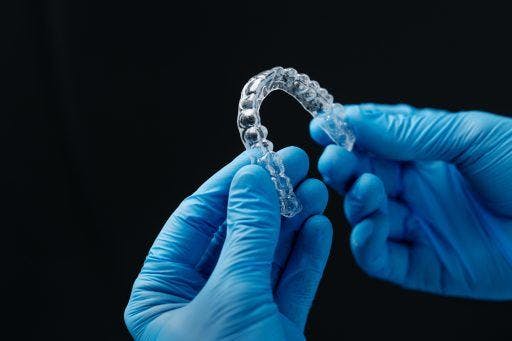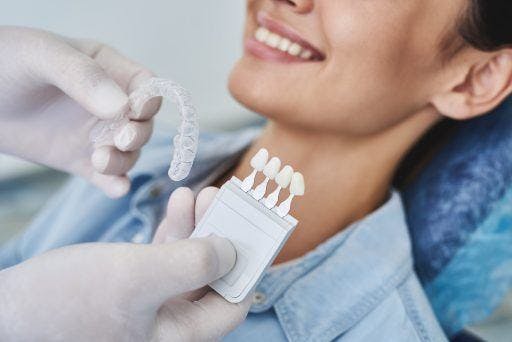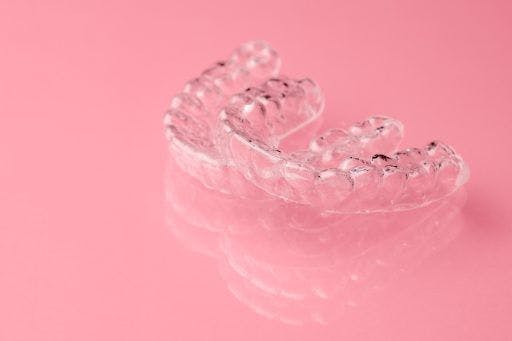Are you dissatisfied with your smile due to crooked teeth? Traditional metal-wired braces are a familiar fix but are not your only option. These days, invisible aligners are becoming increasingly popular – especially among adults looking for a more discreet and comfortable remedy. But before you ring your orthodontist to schedule an appointment, you should have all the facts first.
So, how exactly do clear aligners work? Could they be the right choice for you? Learn all about the science behind the aligners and the proprietary materials used to make them. Plus, the potential pros and cons that come with this style of orthodontic treatment.
The Materials: What Are Invisible Aligners Made Of?

These “invisible” teeth aligners are virtually undetectable and custom-made to fit your teeth. Brands engineer their versions differently, with some choosing a single-layer plastic and others having as many as three. The performance of polymers varies depending on the conditions, so you must consider the materials when choosing an aligner.
For instance, ClearCorrect uses a medical-grade, triple-layer plastic material called ClearQuartz to create durable, stain-resistant aligners that apply gentle, consistent pressure on teeth.
Aligners are designed to maintain their shape and grip over time. They stay firmly in place and do their job without relying too much on “engagers” (small tooth-coloured bumps). As a result, you get effective treatment that looks good and stays comfortable while doing the job, all for the long term. However, you must wear your aligners consistently during the recommended duration if you want to reap their effects.
The Science: How Do Invisible Aligners Work?

To better understand the mechanics of aligners, it helps to have background knowledge of orthodontics and dentofacial orthopedics. Mouth Healthy defines it as “the formal name of the dental specialty concerned with the diagnosis, prevention, interception, guidance, and correction of bad bites.” A bad bite includes malocclusions like crowding, inconsistent spacing, and other abnormalities in alignment. Orthodontic treatment helps correct these issues.
Transparent aligners are an appliance that orthodontists use to help patients develop a “healthy bite” or, as Mouth Healthy puts it, “straight teeth that properly meet opposing teeth in the opposite jaw.” A healthy bite allows you to have an easier time eating and speaking, which improves your overall quality of life.
According to Orthodontics Australia, clear aligner treatment generally “uses a series of clear plastic aligners to ease your teeth into a new position. Each aligner in the sequence has minute differences that apply gentle pressure to the teeth that need to move.”
If you feel that aligners can help solve your dental problems, visit an experienced specialist who can diagnose your situation and recommend the best possible solution. In the case of aligners, an orthodontist will first need to capture the shape of your teeth by taking comprehensive scans before starting your treatment. Based on those, the orthodontist will prescribe how to straighten your teeth. Essentially, they’ll map out your teeth’s journey from misaligned to aligned.
ClearCorrect creates 3D models for each phase of that journey. These models serve as the basis for your clear aligners. Once the aligners are in, they apply light pressure on your teeth to push them closer to the desired position. Each aligner in the sequence differs slightly from the previous one since your teeth should steadily progress as planned throughout your treatment.
ClearCorrect dives deeper into the process and biology of clear aligner therapy in this informative and illustrated walk-through. Essentially, aligners apply pressure to move your teeth towards a straighter, more correct position. You adjust with a new set of aligners as your teeth shift until you reach your desired results.
The Benefits and Limitations: Are Invisible Aligners for You?

Now that you know more about the magic behind invisible teeth braces, you’re better equipped to weigh your options. As a form of orthodontic treatment, aligners offer numerous benefits – but they come with a few limitations, too. Always consider both sides in your decision.
The Benefits of Transparent Aligners
Here are some perks you can enjoy if you use aligners:
- Can you see invisible braces? Aligners have a more subtle design that means most people won’t even realise you’re wearing them.
- Unlike traditional braces’ cumbersome brackets or wires, these aligners won’t dig into your gums.
- You can remove them when you brush, floss, and eat as normally do. You may even forget you’re undergoing treatment!
Some Disadvantages of Aligners
Learn a few drawbacks of using dental aligners:
- Since these invisible braces are removable, you must remember to wear them. Traditional braces are a “set it and forget it” type of deal, while aligners require the wearer to be consistent.
- For best results, you must commit to wearing these for 20-22 hours every day.
- Their removable nature also entails a higher risk of misplacing them in between meals or dental hygiene tasks.
- Last but not least, aligners are the solution to a multitude of malocclusions, but some complex cases may be better addressed with traditional braces.
Ultimately, it’s best to consult with an orthodontist when deciding if invisible aligners are the right fit for you. In the meantime, keep doing your research by visiting the ClearCorrect website and equip yourself with all the need-to-know info.
References:
American Dental Association. (n.d.-b). Orthodontics. Mouth Healthy.
Australia, O. (2023b, March 8). Different Types Of Braces for Teeth. Orthodontics Australia.



